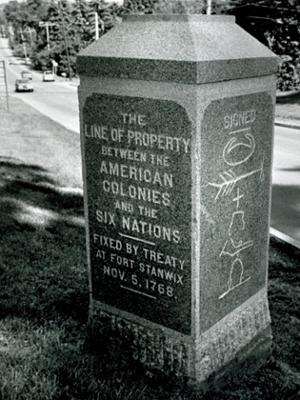
This bit of local history began with the encroachment of white settlers into Iroquois lands in the mid-1700s here in the Colony of New York. British Crown Indian Agent and Superintendent Sir William Johnson tried unsuccessfully to get the Indians to agree to a boundary line that would clearly mark lands open to English settlement and those set aside for the Six Nations and their allies south. The first attempt occurred at a council held at German Flatts in 1765. “The Indians were exasperated and defiant, and the colonists were apprehensive of a general declaration of war,” said an account in the Clinton Courier of July 7, 1885.
Johnson persisted and called another council at Fort Stanwix in today’s Rome for September 1768. He arrived on the 19th, accompanied by his deputies Guy Johnson, Daniel Claus and George Croghan. Other notables there were William Franklin, colonial governor of New Jersey, along with two other New Jersey officials and a representative from Pennsylvania. As was customary, Johnson and party arrived with 20 large bateaux loaded with presents to “propitiate the Indians.” The council finally convened Oct. 3 after 3,200 representatives from the Iroquois, Delaware, Shawnee and other tribes had gathered, causing anxiety that supplies sent would be exhausted. The Clinton Courier article said of the “large and momentous gathering" that there was “no assemblage of equal importance to the future of the country.”
Two full days were devoted to condoling with the Indians on their losses in a recent Canadian war. Sir William Johnson told them the King had instructed him to “terminate forever the grievances by the definite establishment of a boundary line.”
The agreed-to line began at the mouth of the Tennessee River, ran up the Ohio River to Pittsburgh, across the Allegheny Mountains to the east branch of the Owego and Delaware rivers, up the Delaware to the west branch of the Unadilla River to its head and then in a straight line to the carrying place between Wood Creek and the Mohawk River. Called the Line of Property or sometimes the Fort Stanwix Treaty of 1768 Line of Property, it ran southeast to northwest through the town of Kirkland. Hamilton College is west of the line, in then-Iroquois territory.
As for the marker and its connection to Hamilton College, we jump more than a century and turn to a May 1885 issue of the Hamilton Literary Monthly. The U.S. government had assigned Army and Navy officers to a few colleges in the nation, and Hamilton got Lt. Robert Gracey Denig, a member of the Corps of Engineers, U.S. Navy. Lt. Denig taught applied mathematics, field surveying, mechanical drawing and engineering. Sophomores were required to take his class, and juniors could elect one. The Literary Monthly reported that Lt. Denig "took pains to find the correct bearing of the line of property and with the aid of students resurveyed it." Denig suggested that the line be appropriately marked by a monument where it entered College property.
 The Class of 1887, then sophomores, took on the project, and Professor Edward North, Class of 1841, aided with the inscription; the stone was erected by the Psi Upsilon house in late June 1885. The Clinton Courier of June 3, 1885, said that the scheme of marking the line had been a favorite one of Professor Oren Root, Jr., for a number of years, but until the Class of 1887 took the matter in hand, no class seemed “patriotic enough to comply with the suggestion.”
The Class of 1887, then sophomores, took on the project, and Professor Edward North, Class of 1841, aided with the inscription; the stone was erected by the Psi Upsilon house in late June 1885. The Clinton Courier of June 3, 1885, said that the scheme of marking the line had been a favorite one of Professor Oren Root, Jr., for a number of years, but until the Class of 1887 took the matter in hand, no class seemed “patriotic enough to comply with the suggestion.”
On the four sides:
- “The Line of Property Between the American Colonies and the Six Nations / Fixed by Treaty at Fort Stanwix Nov. 5, 1768”
- “Witnessed by Sir Wm Johnson agent for the Crown / Resurveyed June, 1885, by Lieut. R.G. Denig, U.S. Navy”
- “Erected by the Class of 1887 Hamilton College” and then the Greek phrase “Wisdom is the first thing”
- The six symbols, from top to bottom, of the Mohawk, Oneida, Tuscarora, Onondaga, Cayuga and Seneca tribes
While the 1768 treaty line appears in atlases such as the 1907 New Century Atlas of Oneida County, it hardly slowed or stopped New England settlers from moving west. For 124 years the granite monument has marked the historic treaty line, and although the line was a failure in Indian policy, the stone can remind us of the New York colonial period every time we pass it.
Posted July 15, 2009
